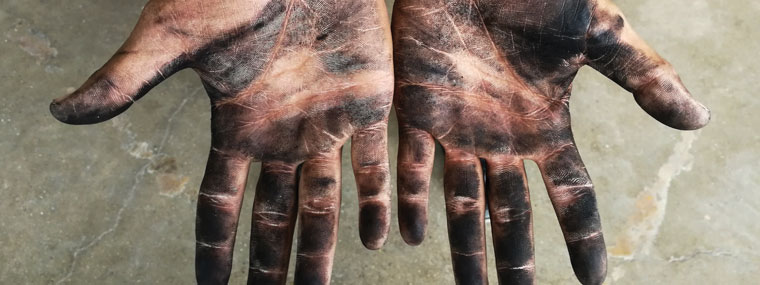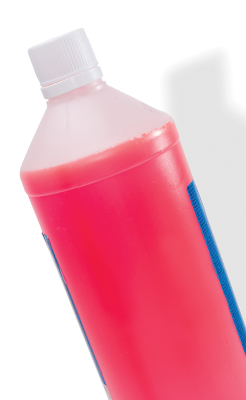
Coil Troubleshooting
By Dan Galvin / Published July 2022

When it comes to power washing equipment, coils are on the low-end ranking of troublemakers. Over the years I have seen three main problems with them: they freeze, soot, and scale up. The problems that follow are the most likely coil-related troublesome situations.
Problem: Water is Pouring Out of the Bottom of the Coil.
Solution: Check for a freeze-up. A simple cause-and-effect situation happens when a coil is exposed to low temperatures—the water inside the coil will freeze. When water freezes, it creates pressure anywhere from 25,000–114,000 psi, depending on the temperature. At those pressures, your coil will burst.
Believe it or not, coils freezing up is more of a problem in the warmer parts of the country where it doesn’t freeze often. People living in warmer climates usually don’t have to think about their pressure washer freezing and/or freeze prevention. In contrast, as a Northerner now living in Georgia, I can tell you from experience—up north winterizing is a part of life. It’s built into our operational schedules.
There are three ways to prevent your pressure washer coil from freezing up. Keep it warm, drain or blow the water out with compressed air, or winterize it with antifreeze.
- Keep it warm. I think the best and easiest way to prevent your pressure washer coil and parts from freezing is to store them where it’s warm, such as a shed, garage, or warehouse. Not just your equipment stays warm, but your cleaning detergents and water in your tank will be ready to go when you need them. The downside to this, as anyone who lives up north and has lived through a blizzard knows, is that your power can be out for five or more days due to a storm, and your equipment can freeze during that time.
- Drain or blow the water out with compressed air. I have seen pumps with air valves (looks like a car tire valve) on them but personally have never used this method because it seems you could never get all the water out of the system. You’re removing water not just from the coil, but also from the pump, unloader, supply lines, bypass lines, hoses, trigger guns, lances, and any other components as well. Again, it’s not the best way to winterize your pressure washer coil.
- Winterize your coil/pressure washer with antifreeze. This option takes more time than the other ways; however, it’s the safest way to protect and store your equipment during the winter months. The best way to winterize your equipment is to use non-alcohol antifreeze because alcohol will eat away at the seals in the pump. Most RV/marine antifreeze does not contain alcohol. However, if all you have is the windshield washer antifreeze that is alcohol based, I have and did use it in emergencies, but only overnight until I could get the proper antifreeze.
Remember to run the antifreeze through your pump, coil (if you have one), hoses, trigger gun, lance, and most importantly, the bypass line, which often is overlooked. Once the antifreeze starts coming out of your nozzle, let go of the trigger and let the antifreeze run through your bypass hose. Make sure you take the bypass hose out of the water tank so you don’t get antifreeze in the tank. The average pressure washer with a coil and 150 feet of hose can use up to five gallons of antifreeze.
If your bypass goes from your unloader and back into your water filter on the pump, you will want to release the trigger on the gun as soon as the antifreeze starts going into the pump. This enables the unloader to go into the bypass and get the water out of the bypass hose. This should only take about one second if your bypass hose is less than five feet.
Safety Warning: DO NOT try to melt the ice in your coil with your burner. The ice in the coil will melt before the ice blocking the inlet and outlet, the coil can become superheated, and with both ends being blocked by ice, BOOM! A steam explosion will result.
Problem: My Burner is Running All the Time but Never Heats Up.
Solution: Scaling is like hardening of the arteries to your coil. Scale not only reduces the water flow through your coil: it is also an excellent insulator and will greatly reduce your coils’ efficiency. Your burner will continually be running, trying to heat up the water that will never reach its operating temperature because of the scaling.
To help prevent scaling, use water softeners if you live where there is hard water. Some pressure washers have built-in water softening systems. It’s a best practice not to run detergent chemicals through your coil as they can contribute to scaling. If you do run detergents through your coil, make sure they have water softening agents to help reduce scaling deposits.
Descaling a coil requires the use of heavy-duty acids, and if you have a coil that requires descaling, hire a professional to do it for you. Or you could always do what I would do: buy a new coil because that scaled-up coil has already paid for itself a thousand times over.
Problem: The Burner is Smoky, and the Water Isnt’ Getting Hot.
Solution: Sooting is a problem that reduces the efficiency of your coil due to a buildup of carbon deposits, which insulates the outside of the coil. The deposits can also build up between the coil piping and block the heat/flame from going around the pipes.
You don’t always see smoke for sooting to occur; there are flue gasses that do not have visible smoke but can cause heavy sooting. The use of dirty or heavy fuel oil and your burner not burning properly will cause heavy sooting. Kerosene, which is more expensive, has less carbon in it than fuel oil and will burn cleaner with less sooting.
Now the good news is you can remove and clean the coil yourself. The bad news is you probably won’t want to. I don’t know if this has been on the TV show, Dirty Jobs, but it should be. The soot goes everywhere! I don’t care how suited up you are, that soot will find orifices on your body you didn’t know you had. If you’re thinking, I’ll just use my other pressure washer to wash it off, think again. The soot does not mix well with water, and it floats on top of the wash water and goes everywhere that water goes, leaving a big mess behind. On top of that, once the water dries, you’re left with the soot spread out where it can be walked on and tracked everywhere. You need to carefully consider where you should clean the soot off the coil.
With coils there’s not much troubleshooting; it’s more about service and preventive maintenance on the equipment. If you decide to maintain your own equipment, remember to follow all the appropriate safety precautions when doing repair work and try not to track the sooty mess all over your office, vehicle, home, laundry room, and Walmart—you get the idea.
Dan Galvin is EnviroSpec’s president and CEO and has worked in the power washing industry for 20 years. If you have more questions for Dan, contact him at (800) 346-4876 or visit www.envirospec.com.







